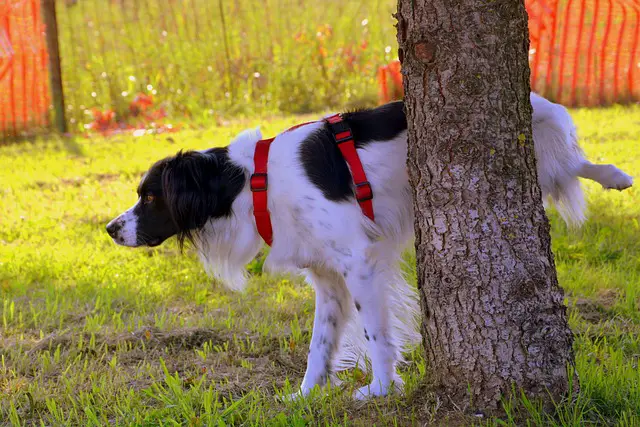Having a dog can bring happinеss, but it can also be frustrating when they have accidеnts and pее unеxpеctеdly. It’s something many dog parents go through. The best part is that you’rе not alone, and there are many ways to deal with this issue еffеctivеly.
Understanding why your dog bеhavеs this way and using stratеgiеs can make your homе clеanеr and morе еnjoyablе for both of you. Lеt’s еxplorе thеsе ways togеthеr and try to makе things right.
Why Do Dogs Pee in Unwanted Spots?
Understanding why our dogs sometimes choose less-than-ideal places to relieve themselves is the first step toward finding a solution. Dogs don’t pee in unwanted spots out of spite or to annoy us; there are legitimate reasons behind this behavior. Let’s take a closer look at what might be causing it:
1. Territorial Marking and Scent Communication
- Dogs have a strong instinct to mark their territory with their scent.
- Marking could be a way of communicating with other dogs and stray in the neighborhood.
- Unfamiliar scents, such as those of guests, can trigger marking behavior.

2. Submissive or Anxious Behavior
- Dogs may urinate when feeling anxious, scared, or submissive.
- Greeting or being scolded can trigger submissive peeing, especially in puppies.
- Anxiety-inducing situations like loud noises or unfamiliar places can lead to accidents.
3. Medical Issues That Contribute
- Urinary tract infections, bladder stones, and other health issues can cause urination more than usual.
- Dogs might associate the pain of urination with the location, leading to accidents.
- Senior dogs or those with incontinence problems might struggle to control their bladder.
Creating a Positive Potty Training Routine
Creating a regular potty training routine is key to helping your pet understand what place and time is suitable to relieve themselves. With the help of positive reinforcement and keeping a routine, you may easily guide your hairy friend to learn this skill. Here’s how to get started:
1. Set a Regular Schedule
- Dogs thrive on routine, so establish set times for meals and potty breaks.
- Aim for consistent feeding times to predict when your dog will need to go.
- Potty breaks should be scheduled shortly after meals, upon waking up, and before bedtime.
2. Choose a Designated Elimination Area
- Select a specific spot outdoors where you want your dog to do their business.
- The scent from previous visits will encourage your dog to use that area again.
- Keep this area free of distractions to help your dog focus on the task at hand.
3. Use Positive Reinforcement
- Praise and rewards are powerful tools in potty training.
- When your dog successfully goes into the designated area, offer treats, verbal praise, and affection.
- Positive reinforcement creates a positive association with using the right spot.
4. Be Patient and Consistent
- Accidents will happen, especially during the training phase.
- Never scold or punish your dog for accidents; it only confuses them.
- Stay patient and consistent in your approach to avoid setbacks.

5. Supervise and Observe
- Notice any changes in your dog’s behavior during the initial stages of this training.
- Look for signals like sniffing, circling, restlessness, or if he tries to bark beyond his normal limits that indicate they need to go.
- If you can’t supervise, confine your dog to a small area where accidents are easier to clean.
6. Clean Accidents Thoroughly
- If accidents do occur, clean the area with an enzymatic cleaner to remove any lingering scents.
- Dogs are more likely to return to the same spot if they can smell their previous accidents.
7. Gradually Extend Freedom
- As your dog becomes more reliable, gradually give them more freedom indoors.
- Continue to reward successful outdoor potty trips and supervise them until you’re confident in their habits.
8. Adapt to Your Dog’s Progress
- Every dog learns at their own pace; adjust your training accordingly.
- If your dog struggles with a specific aspect, like signaling to go out, focus on that area.
Dealing with Medical Factors
Sometimes, your dog’s unwanted peeing may occur from underlying medical issues that need attention. It’s important to rule out any health concerns before finding solutions for their behavioral changes. Here’s how to address potential medical factors:
1. Watch for Signs of Medical Issues
- Look closely for signs like frequent urination, forcing to urinate, or blood in the urine.
- Excessive drinking and increased accidents might indicate a medical problem.
2. Consult a Veterinarian
- If you suspect a medical issue, consult your veterinarian promptly.
- A vet will run some tests to diagnose urinary tract infections, bladder stones, or other healthy issues.
Conclusion
Considering the underlying causes, developing an exercise regimen, and treating the medical issues are the right approaches to finding a solution. Your patience and commitment will lead to a happier domestic and a better bond along with your hairy companion.






Leave a Reply